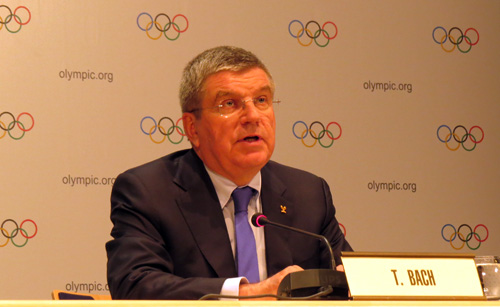New logos representing the Beijing 2022 Olympic and Paralympic Games were launched Friday at the National Aquatics Centre in the Chinese Capital. At precisely 20:22 local time during a ceremony at the ‘Water Cube’, a planned venue for the Games in 2022, Chinese Vice Premier Zhang Gaoli, International Olympic Committee (IOC) Vice President Yu Zaiqing and Beijing 2022 President Cai Qi revealed the new logos.
The new logos will be showcased as part of the official Olympic Winter Games handover ceremony at the PyeongChang 2018 closing ceremony set for February 25 next year.
The emblems, named “Winter Dream” and “Flying High”, were designed by Deputy Dean of China Central Academy of Fine Arts’ Design School Lin Cunzhen who was also the artist behind the logo for the Nanjing 2014 Youth Olympic Games.
Cunzhen also created the designs for the Beijing 2022 bid logo, the branding used when the city was competing with Almaty in Kazakhstan for the right to host the Games. Beijing became the first ever host city for both the Winter and Summer editions of the Olympic Games.
New @Beijing_2022 logos for #Olympics and #Paralympics are finally revealed. What do you think? https://t.co/0CoylTQAzZ
— GamesBids.com (@gamesbids) December 15, 2017
Her entry was one of 4,000 proposals submitted to the Games Organizing Committee during a process that began mid-2016 and wrapped up just weeks ago when the IOC gave its approval for the final design. The branding will soon appear worldwide and be used to promote the Games and the sales of official Olympic merchandise.
[box style=”0″]
‘Winter Dreams’ Olympic Winter Games Emblem
The inspiration of the emblem design comes from the Chinese character for winter — “冬”. A stylised, calligraphic rendition of the Chinese character, which infuses Chinese culture with contemporary artistic elements, projects a new image of China in a new era, demonstrating the country’s commitment to a successful Winter Games. It also heralds the realisation of China’s Winter Olympic Dream, namely, to encourage more Chinese people to take part in winter sports, to build China into a sporting power, and to promote winter sports and the Olympic Movement around the world.
The upper part of the emblem resembles a skater and its lower part a skier. The ribbon-like motif in between, full of rhythm, stands for the host country’s rolling mountains, Games venues, ski courses and skating tracks. The ribbons, as artistically expressed in the emblem, give a touch of festivity and are an indication that the Games coincide with the celebrations of the Chinese New Year.
The emblem’s primary colour of blue represents dreams and the future, as well as the purity of ice and snow. The colours of red and yellow, which draw on those of China’s National Flag, represent passion, youth and vigour. The presentation of the words “Beijing 2022”, a nod to the art of Chinese calligraphy and paper-cutting, adds to the harmony of the entire emblem.
Source: Beijing 2022
[/box]
[box style=”0″]
‘Flying High’ Paralympic Winter Games Emblem
The emblem is designed to present the host country’s culture and highlight the Games organisers’ athlete-centred philosophy. It draws inspiration from the vigour and strength implied in the Chinese character for flying – “飞”, pronounced fei.
In a vivid way, the emblem evokes the image of an athlete in a wheelchair rushing towards the finish line and victory. The robust strokes in the upper part and the soft curves below symbolise Para athletes striving for excellence despite their physical disabilities. The emblem embodies the Paralympic spirit that aims to enable Para athletes to achieve sporting excellence and inspire and excite the world.
With its impressive colour scheme and well-balanced composition, the emblem seeks to convey a message of strength, passion and dynamism. It encourages all athletes to fly high on the wings of their aspirations.
Source: Beijing 2022
[/box]



